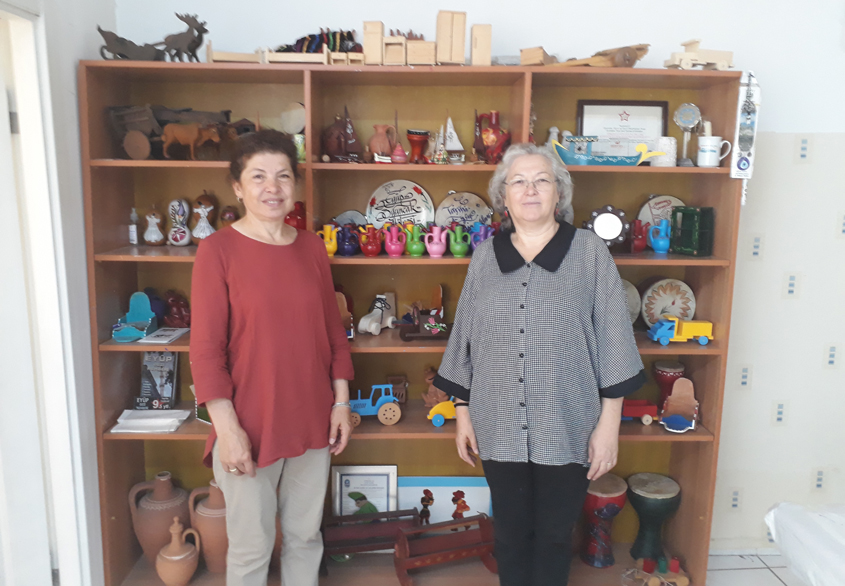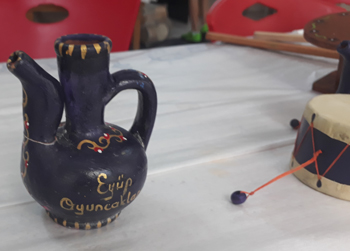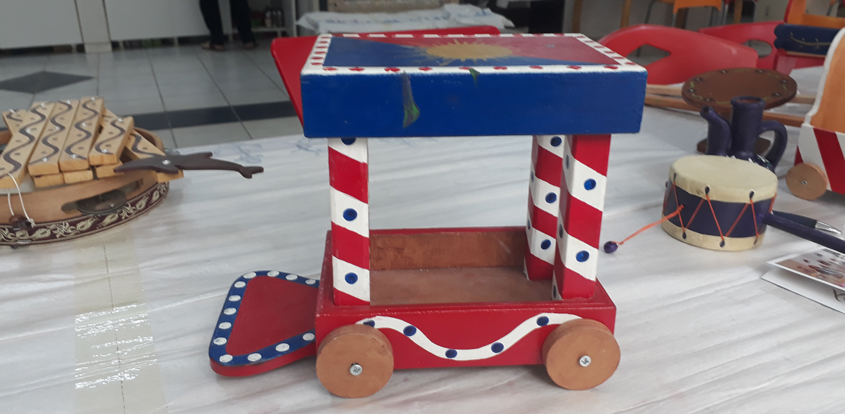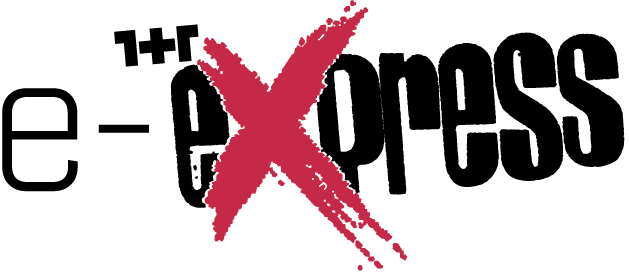How can a handful of women revive a five hundred-year tradition, which seems to have been put upon dusty shelves of history? How can a craft develop day by day in twelve years by developing carpentry skills? Despite the dwindling interest of the public and municipalities, how does this craft continue to live on? Two members of the Women’s Cooperative for Historical Eyüp Toys, Asuman Ustaoğlu and Gönül Sekizkardeş tell their story.

How did you first meet with the historical toys of Eyüp?
Asuman Ustaoğlu: In 2005, the EU, Turkish Employment Agency and the History Foundation of Turkey jointly launched a project, which aimed to provide employment opportunities for the women of Balat-Fener, a historical district of Istanbul. The main purpose was to revive the historical toys of Eyüp. Including myself, six women attended the training which was offered. After the training, the six of us passed on this knowledge to fifty-six people who attended courses. I am a housewife. Before joining the project, I had no knowledge of Eyüp toys or its history. Actually, this tradition had long been forgotten in this neighborhood.
Gönül Sekizkardeş: There were one or two toys, like the clapper drum and the whistling jug. Nobody really knew that these where Eyüp toys. When boys are brought to visit Eyüp Sultan [Mosque] on the day of their circumcision celebrations, they get a lot of toys including these toys.
 Asuman: The mayor of the time, Ahmet Genç of the AKP, provided a place for us on Zalpaşa Road. We had all our equipment in that place. Our trainer was Prof. Tosun Yalçınkaya, an academic staff member of Marmara University. We learned how to make moulds and carpentry with tools. At first, we had some hesitations, but we became comfortable as time went by. We received three months of training, and then we started to share our knowledge with other women.
Asuman: The mayor of the time, Ahmet Genç of the AKP, provided a place for us on Zalpaşa Road. We had all our equipment in that place. Our trainer was Prof. Tosun Yalçınkaya, an academic staff member of Marmara University. We learned how to make moulds and carpentry with tools. At first, we had some hesitations, but we became comfortable as time went by. We received three months of training, and then we started to share our knowledge with other women.
How did you learn about the history of the toys and the toy making process?
Gönül: All of these toys require carpentry skills. It’s not really women’s cup of tea. You get used to the manual sander pretty quickly, but mastering the machinery takes much longer. We learnt how to paint before or after the joinery work. In the beginning we wasted a lot of timber. Also, we were using oil-based paints in the beginning and we had to wait for days for the paint to dry. We had no experience with any of the materials we were introduced to. For example, how were we going to sew the clapper drums? No one had an original toy that we could use as a model, so we discovered the finer aspects of the work by ourselves. There are only 28 historical Eyüp toys at the Istanbul Municipality Museum. It is impossible to make the exact replicas of these toys. For example, there may be a whistle made of intestine. We have no original toys as samples, and they cannot allow us to have the ones at the museum. They showed us photographs of the toys. To make a drum, you have to bend the timber, fit the rims and nail the leather.
We did not want to leave what we started unfinished, and so we were trying to find a solution. To be a foundation means to be a non-profit organization. The members of KEDV recommended that we should consider the cooperative model.
Sometimes it takes us weeks to discover the right methods. For example, the bellow toy (“Devil’s Ladder”) is actually much larger, but we have only been able to make them in small size. It took days to be able to match the holes. We only had photographs of this awful sounding toy, the clapper, which is known as the “mother-in-law”. (laughs) Of course, four hundred years ago, mother-in-laws lived in the same house and the toy is inspired by this experience – I guess the daughter-in-law was not so happy with the arrangement. We only recently increased the price of the wooden cars to sixty liras. The tambourines or drums are not just toys, they are also used as instruments of percussion. Now, we also make toys which are not historically traditional, such as tractors, trucks, cars. Maybe the cradle or the little cupboards attract the girls, but all children really do take interest in the toys. The learning process is a test of patience. Some of our friends did not have the patience and did not continue. At the time we decided to become a cooperative, our numbers had gone down from sixty to twelve.

Asuman: After the course, some of the women left us, for the reason that their husbands did not allow them to continue as it was not income generating. During the training course, IŞKUR, the Turkish Employment Agency, was providing a very small payment to women, but not to those on retirement. When these payments stopped, we were left with only a handful of people.
What was the economic capacity of the cooperative in the initial stage?
Gönül: There was no income. But we found the strength to continue as a small group in the workplace allocated to us by the Eyüp Municipality. If, at the time, we had to pay rent like we do now, we would never have been able to undertake this challenge. We used the venue until the new mayor of the AKP took the venue back in 2012. They told us to “close down the cooperative and select two women out of the group to come and work under the roof of the municipality” and the rest of the women “would have to take make their own means elsewhere”. The municipality did not want a cooperative, they preferred to have a unit under their control.
We don’t have to obey anyone, so to speak. We are free. We do our own work. We are creating things, we provide the children a cultural perspective.
Asuman: In fact, by that time, we had mastered the work that we were doing, and we already had some media coverage. We considered some of the recommendations we received and decided to start our own “paint your own toys” courses. We were making the toys, children and families paid a fee to paint them. They were allowed to take home the toys they painted. The parents were very happy. And so, we came to see that we could stand on our own feet and we rented this place for six years.
Who were the members of the core group that stayed together after the training course?
Gönül: The children of the women in that group were grown up and they did not need constant care and support. Our marriages, family lives, had a certain maturity and we had regular lives in general. Therefore, we did not have a big financial expectation out of this. Quite the opposite; other courses we were attending requested money from us. But here, we had a chance to actually generate an income. I’m retired and I do not have to pay rent. But we have to continue to be active in life; we have to make a contribution to society. I took an early retirement, and this left with a certain emptiness in my life. When I heard about the idea of the cooperative, I thought, “I don’t have to pay to be involved in this”. Of course, things didn’t really work out that way. In the process of developing the cooperative, we all made some financial sacrifices, but it is not something that we resent.
Yasemin: We don’t have to obey anyone, so to speak. We are free. We do our own work. We are creating things, we provide the children a cultural perspective. This freedom is very valuable. We organize painting courses to make our keep. Professor Yalçınkaya told us that he never thought we would last this long! We pay a monthly rent of two thousand liras; we do not get any subsidy as a cooperation. We also have to pay withholding tax and the 18 percent VAT.
Some say, “Isn’t it an expensive price for a piece of wood?” People have different viewpoints. Where one person sees a piece of wood, another sees a valuable piece of handcraft.
Did you plan to be a cooperative when you started the project?
Gönül: No. We did not want to leave what we started unfinished, and so we were trying to find a solution. To be a foundation means to be a non-profit organization. For cooperatives there’s no such rule. It is very important for a woman not to be financially dependent on her husband.
Yasemin: During the training courses, we met with the members of KEDV, the Foundation for the Support of Women’s Work. They recommended that we should consider the cooperative model. The year 2006 was a milestone for us. Many women’s cooperatives were established in Kasımpaşa, Gültepe, Kâğıthane districts of Istanbul as well as in many other cities throughout Turkey.

Do you have any other plans to generate income, besides the courses and workshops?
Gönül: Our biggest shortcomings are marketing and promotion. We cannot be very active on the internet, due to our age disadvantage. Our children have their own worries, they can spare only a limited time to help and support us. This is one of the reasons our website is not very active.
Has any other organization offered their support in passing on this valuable craft?
Yasemin: We are in contact with some organizations and companies through KEDV. A company, which does not want to be named, organized an event for their employees where the members of three women’s cooperatives were invited. There we painted toys together. Sometimes we participate in such events. However, we do not have a regular collaboration with other organizations. The KEDV provides free of charge advisory to us. They also purchase our products in small quantities.
If interest and support can be generated, the toys of Eyüp could be renown just like the Babushka Dolls or the clogs of the Netherlands.
Gönül: I think the public does not really comprehend what we are doing. Some people say, “Isn’t it an expensive price for a piece of wood?” But in fact, sometimes we put up toys for sale under their value, let’s say fifty liras for what we have spent two days to produce. We don’t really have much sale in the store at Eyüp. Unfortunately, people buy toys made in China for two-three liras, which are poor quality and unhealthy. But considering the economic circumstances, I can’t blame them.
Yasemin: People have different viewpoints. Where one person sees a piece of wood, another sees a valuable piece of handcraft.
Do you have regular cooperative meetings? How does the cooperative take decisions and share the earnings?
Yasemin: We do not have regular meetings like other women’s cooperatives. We take decisions jointly in when we gather here in the workplace. We have our meetings while we are working. Everyone logs their attendance in the record book when they arrive. Then we look at the hours contributed and share the earnings accordingly. Nobody intervenes in the decisions we take for. If we need advice on a matter, we consult the KEDV.
If you had more support or better financial opportunities, what would be your priorities?
Yasemin: We would like to find an appropriate venue suitable for the history of the toys. It is not just a matter of being in a historical neighborhood. We can add value to the place we are now. Currently, here, we are in an apartment building and we make the toys in the basement. But it isn’t congruent with the history of the toys. If interest and support can be generated, the toys of Eyüp could be renown just like the Babushka Dolls or the clogs of the Netherlands. If we had a budget, we would use it for promotion. We could get support in using social media and to also make our website more active. Perhaps then we may not be challenged with trying to ensure organized production and getting more people to join the cooperative. We can produce these items, but if we cannot sell them, then what is the point of production? Up to now, we have gained a lot of visibility if you consider that it is the outcome of our amateur efforts. From this point on, we need a promotion strategy to become visible all over the country and abroad as well. If we could just get this off the ground, it will be possible for us to provide regular courses to everyone and women in particular.
Translated by Ebru Pepedil





